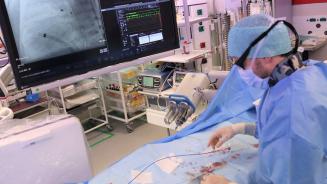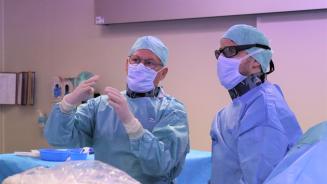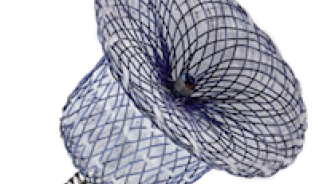Pediatric Cardiology: Effectively Treating Heart Defects Without Open Surgery
The pediatric cardiologists at HUDERF offer cutting-edge treatments such as interventional catheterization for infants. This technique provides a less invasive and safer alternative
Excellence in Pediatric Cardiology at the Children's Hospital.nfants
Idriss, a premature infant, received a critical intervention using an advanced technique: interventional catheterization.
Suffering from patent ductus arteriosus (PDA), a common heart defect in premature infants, Idriss was treated by pediatric cardiologists Drs. Nicolas Arribard and Hugues Dessy. Their precise and non-invasive intervention successfully closed the ductus arteriosus, thereby preventing severe respiratory and cardiac complications and significantly improving Idriss's breathing and quality of life.
A prosthesis, designed to return to its original shape thanks to its shape-memory metal, was selected and inserted through the blood vessels and heart to the ductus arteriosus
An Innovative and Less Invasive Treatment
Interventional catheterization offers numerous advantages over traditional open-heart surgery. It is a far less invasive method, allowing for quick recovery and reduced postoperative risks. The pediatric cardiologists at HUDERF use flexible prostheses that adapt to various sizes of ductus arteriosus, ensuring a secure and effective closure of PDA.
Using small plastic catheters, the cardiologists navigate to the heart
Understanding Patent Ductus Arteriosus (PDA)
The ductus arteriosus is an essential blood vessel in fetuses, allowing blood to bypass the non-functional lungs before birth. This duct normally closes shortly after birth. However, in some premature infants, it remains open, leading to abnormal blood flow that overloads the lungs and heart. Without treatment, this condition can cause severe respiratory and cardiac complications.
Interventional Catheterization: The Steps of the Procedure
Femoral Vessel Puncture: The procedure begins with a puncture of the femoral vessels to access Idriss's heart.
Navigation to the Heart: Using small plastic catheters, the cardiologists navigate to the heart.
Use of Contrast Agent: Once there, they use a contrast agent to obtain precise images of the ductus arteriosus, determining its exact size.
Selection and Insertion of the Prosthesis: A prosthesis, designed to return to its original shape thanks to its shape-memory metal, is selected and inserted through the blood vessels and heart to the ductus arteriosus.
Position Verification: Drs. Arribard and Dessy then verify the correct positioning of the prosthesis before completing the procedure.
Info: Cardiology (Pediatric) | Queen Fabiola Children's University Hospital (huderf.be)




